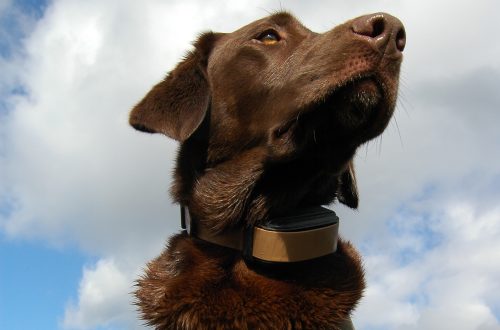
Wireless Fence For Dogs
A wireless fence for dogs is an alternative to traditional fencing that allows dogs to safely roam and play within set boundaries without physical barriers. It uses a radio signal transmitted from an indoor transmitter to a receiver collar worn by the dog, which emits a warning tone when the dog approaches the boundary. If the dog continues to move closer to the boundary, it receives a static correction to discourage it from crossing. Wireless fences are a convenient and effective solution for pet owners who want to keep their dogs safe and secure within a specific area.
Benefits of a Wireless Fence for Dogs
Wireless fences for dogs can be a highly effective and safe way to keep your furry friend contained. Most dogs can learn how to properly use a wireless fence with proper training, making it a great option for many pet owners.
These fences provide precise boundaries and keep dogs safely contained without obstructing your view. This means you can easily keep an eye on your pet while they run and play. Additionally, wireless fences can be a great safety feature for dogs, as they prevent them from wandering into busy streets or other dangerous areas.
One of the biggest benefits of a wireless fence is the convenience factor. Unlike traditional fences, you don’t have to worry about installing and maintaining a physical fence. This can be a significant cost savings over time, and it also means you don’t have to worry about the fence obstructing your view or taking up valuable space in your backyard.
While wireless fences are generally safe for dogs, it’s important to note that proper training and use of the collar feedback are important to prevent fear or aggression. As with any pet training tool, it’s essential to be patient and consistent when introducing your dog to its new fence.
Types of Wireless Fences For Dogs
Wireless fences for dogs have become increasingly popular among pet owners in recent years. They offer a convenient and effective way to keep your pet within a specific boundary without the need for traditional physical fences. If you’re considering a wireless fence for your furry friend, it’s important to understand the different types available on the market to find the best option for your specific needs. In the following sections, we’ll explore the various types of wireless fences for dogs and their features to help you make an informed decision.

Invisible Fences
Invisible fences have become a popular choice for dog owners looking for a secure and effective containment system to keep their pets safe and within designated boundaries. Also known as wireless fences or virtual fences, invisible fences provide an alternative to traditional physical fences that can be expensive and may obstruct views.
The concept of invisible fences is to provide an unobtrusive barrier using radio signals to restrict a pet’s movement within the designated area. The system uses a transmitter and a receiver collar that works with the radio signals to ensure the dog stays within the set boundary. When the dog reaches the boundary, the receiver collar produces a warning beep followed by a static correction to discourage the pet from crossing the boundary.
In comparison to traditional physical fences, invisible fences have several advantages. They offer precise boundary control, and pet owners can set specific circular boundaries, which can be customized to the pet containment area’s size and shape. They are also relatively easy to install, and owners can usually set up the system themselves, saving money on professional installation costs. Wireless fences are also more affordable than physical barriers, making them a popular choice for budget-constrained pet owners.
However, invisible fences also have their disadvantages. Some dogs may be able to overcome the static correction and become fearful of the collar, leading to unwanted behavioral changes. Invisible fences also do not prevent other animals or people from entering the containment area, which can be a problem in urban areas where there may be street animals or wild animals. Power outages can make the system obsolete, and heavy thunderstorms can interfere with the radio signals.
Two different types of invisible fences are available in the market. The first type uses static correction, where the receiver collar provides a mild electric shock when the dog crosses a boundary within the containment area. The second type uses virtual fences, which send an alert to the owner’s phone when a dog leaves the designated boundary.
It is essential to consider the pet’s needs and characteristics and the pet containment area’s size and shape when choosing an invisible fence system. The dog’s neck size and sensitivity should be taken into consideration when selecting the receiver collar. Additionally, owners should ensure that the collar is waterproof to prevent malfunctioning during bad weather or when the dog jumps into swimming pools.
Electric/Static Correction Fences
Electric/static correction fences are a popular type of dog fence system that uses a series of wires to emit a harmless static shock to deter dogs from crossing a set boundary. These fences are often used as an alternative to traditional fences and are particularly effective for dogs who are stubborn or have a high prey drive.
Electric fences come in two main types: in-ground and wireless systems. In-ground systems require a bit more work to install, as they involve digging a series of trenches around the designated area, burying the wires, and then connecting them to a transmitter. Wireless systems, on the other hand, are much easier to set up and use as they don’t require wires to be buried. Instead, a transmitter emits a circular signal that creates a boundary.
Regardless of the type of system, electric fences usually come with a receiver collar that fits around the dog’s neck. These collars are designed to deliver a static correction when the dog crosses the boundary set by the fence. It’s important to choose a collar with the correct neck size for your dog to ensure proper function.
To use an electric/static correction fence, first, set up the boundary by installing the wires or transmitter and ensure the receiver collar is fitted correctly to your dog. Then, train your dog to stay within the set boundaries using audible signals and training flags.
Overall, electric/static correction fences can be a great option for pet owners who want to provide their dogs with a safe and secure area to play without the need for traditional fencing. However, it’s important to ensure that these fences are used responsibly and that dog owners take the time to train their pets properly to avoid any unwanted and potentially harmful side effects.
Virtual Fences
Are you tired of digging trenches and burying wires to install a traditional electric fence for your dog? Are you looking for a more convenient and flexible dog containment solution? Introducing virtual fences – the latest innovation in pet safety technology.
Virtual fences use GPS technology to create boundaries for your dog without the need for physical wires or underground installations. Unlike traditional electric fences that create circular boundaries, virtual fences can be set up in any shape and size, giving you more control and flexibility.
GPS-based virtual fences provide the added advantage of managing the boundaries through a mobile app, allowing you to set up and adjust the boundaries remotely. This feature provides an added convenience to busy pet owners who may not have the time to adjust the fence manually.
Halo, a leading provider of virtual fencing systems, offers a GPS-based virtual fence that allows you to set multiple boundaries on your pet’s safety map. You can assign different levels of activity and access to different boundaries, giving you more control over your dog’s safety.
Halo’s virtual fence system also comes with an extended 90-day return period, giving you peace of mind and confidence in your purchase. So if you’re hesitant to try this new technology, you can rest assured that you can always return it if it doesn’t meet your expectations.
Traditional Fences
Wireless fences have become increasingly popular for pet owners looking for a way to keep their dogs safe without the need for physical barriers. However, traditional fences are still a tried and true option for containing your furry friend. In this article, we’ll explore some of the different types of traditional fences available and the pros and cons of each.
Wooden dog fences are a timeless option that blends well with many styles of homes and landscaping. They offer privacy and can be customized to fit the specific needs of your property. However, they can be expensive to install and maintain, and if not cared for properly, they may rot or become infested with insects.
Metal dog fences are a sturdy option that provides a clear boundary line for your pet. They come in a variety of finishes, including wrought iron and aluminum, and can be customized to fit any size yard. However, they are susceptible to rust and may require regular maintenance to keep them in good condition.
Chain-link fences are a more affordable option that provides a clear view of your property. They are often used for larger areas, such as parks or kennels, but can also work well for home use. They are easy to install and require minimal maintenance, but they may not provide the same level of privacy as other options.
When it comes to choosing a traditional dog fence system for your pet, there are several top brands to consider. PetSafe is a well-known brand that offers a variety of wooden, metal, and chain-link fence options. They also offer battery-powered fence systems for those who want the convenience of not needing an electrical outlet. Invisible Fence is another popular brand that specializes in hidden fence systems, with different types of collars to fit any neck size.
Ground Fences
Ground fences for dogs are a classic and reliable way to set up a boundary for your furry friend. Unlike invisible fences, ground fences are installed above the ground and provide a visible barrier that is easy for your dog to recognize. These fences come in different sizes and can be made of materials such as metal or wood, providing a more permanent and sturdy solution compared to other types of pet containment systems.
Ground fences are ideal for pet owners who prefer a physical fence for their dogs, providing a clear boundary line that is easy to maintain. Pet containment with ground fences is straightforward and customizable to fit your dog’s size, breed, and area that needs to be enclosed. Given the variety of options available in the market, selecting the right ground fence for your dog requires careful consideration of certain features.
The material used to construct the fence is an important consideration when choosing a ground fence for your dog. Wooden fences are a popular choice as they are sturdy and blend well with many landscaping designs. Metal fences, such as steel or aluminum, provide a sleek and durable option that can withstand harsh weather conditions.
The height of the fence is another important factor to consider when selecting a ground fence for your pet. Depending on the size and breed of your dog, you may need a taller or shorter fence. Larger dogs will require a higher fence to prevent them from jumping or climbing over, while smaller dogs may need a lower fence that they can easily see over.
The strength of the stakes is also critical, as they provide the support needed to keep the fence in place. Stakes should be deep enough to resist any attempts to dig under the fence. Selecting stakes made of sturdy materials such as steel ensures that your fence remains in place, even during inclement weather.
Circular Boundaries
Circular boundaries are an excellent option for pet owners who want to keep their dogs safe and secure within a specific area. Unlike traditional physical fences, circular boundaries do not require the installation of stakes or any type of visible barrier. Instead, these boundaries use a wireless system to create a circular perimeter for your furry friend.
Circular boundaries have become increasingly popular in wireless dog fences due to their versatility and ease of setting up. Pet owners can adjust the circular boundary range according to their specific needs, making it an ideal choice for dog owners with varying types of properties.
The way circular boundaries work is simple: the wireless dog fence system creates a virtual boundary within a pre-determined radius. When the dog wearing the receiver collar approaches the boundary line, it triggers a static correction, giving the dog a mild and harmless stimulus. Over time, the dog learns to associate the boundary line with the stimulus and stays within the safe area.
Customization and precision are key features of circular boundaries. The system allows you to precisely set the boundary line to a specific distance from the transmitter, ensuring that your dog stays within a safe and secure zone. Moreover, circular boundaries can be customized to suit your pet’s size, behavior, and training goals. This gives you the flexibility to create an environment that encourages positive behavior and reinforces your dog’s training.
When choosing the right circular boundary system, it is important to consider your pet’s size, behavior, and training goals. Smaller dogs may require a smaller boundary radius, while larger dogs will need a larger range. Dogs that are more active or have a history of wandering may need a more robust correction level. Ultimately, selecting the right wireless dog fence with circular boundaries will allow you to create a safe and secure environment that meets your dog’s specific needs.
Considerations When Choosing A Dog Fence System
Choosing the right dog fence system can be a daunting task for any pet owner. With so many options available in the market, it can be challenging to determine which system would work best for you and your dog. Here are some important considerations to keep in mind when selecting a dog fence system.

Receiver Collar and Neck Size Compatibility
When considering purchasing a wireless fence system for your furry friend, it’s important to consider the compatibility of the receiver collar and the neck size of your dog. Selecting a compatible collar that fits properly is crucial to ensure the effectiveness of the system.
Firstly, it’s important to find a collar that is compatible with the specific wireless fence system you choose. Not all collars are universal and may only work with certain systems, so it’s important to double-check compatibility before making a purchase.
In addition to compatibility, selecting the right neck size for your dog is also essential. A collar that is too loose can result in your dog slipping out of the collar, while a collar that is too tight can be uncomfortable or even harmful. The proper fit and tightness of the collar can affect its effectiveness and keep your dog safe.
Most wireless fence collars come in different sizes, ranging from small to large. It’s important to measure your dog’s neck and compare it to the collar size options provided by the manufacturer. Some breeds may have unique neck size requirements, so it’s important to consider that when selecting the right size collar.
Lastly, it’s crucial to replace the collar battery as needed to ensure the system functions properly. Most collars have a rechargeable or replaceable battery and it’s important to follow the manufacturer’s recommendations on when to replace the battery to avoid any interruptions in the system.
Pet Containment Area Specifications
Creating a pet containment area with a wireless fence for dogs is an excellent way to keep your furry friends safe while still allowing them to enjoy the freedom of the outdoors. When planning a pet containment area, several critical specifications need to be considered to ensure that the overall system is functional and safe.
One of the most important considerations is the size and shape of the containment area. Ideally, the area should be large enough to allow dogs to move around freely, exercise, and play. The shape of the area can vary depending on your property’s layout, but most wireless fence systems function well with circular boundaries.
Another critical aspect is the placement of the flags. These flags are used to mark the boundaries and help train your dog to stay within the specific containment area. It’s essential to ensure that the flags are placed in a visible location, ensuring that the dog can see them quickly. Typically, the flags need to be placed at specific intervals, depending on the size of the pet containment area.
The installation of the transmitter is another key area of focus. The transmitter is responsible for emitting the radio signals that communicate with the receiver collar. It’s vital to install the transmitter in a central location in your home, as it needs to be mounted to a wall and plugged into an electrical outlet.
Another crucial factor to consider is compatibility with the receiver collar and neck size. Not all receiver collars are universal and may only work with particular wireless fence systems. It’s essential to ensure that the receiver collar you choose is compatible with the wireless fence system to avoid any problems. Additionally, the neck size of your dog plays a significant role in selecting the right receiver collar size. A loose or tight fit can result in discomfort for your dog and weakening of the system’s effectiveness.
Boundary range is another key determining factor, as it will dictate the distance that your dog can roam outside of the pet containment area. Some wireless fence systems offer adjustable boundary ranges, while others are fixed. It’s essential to consider the size of your property and the space available when selecting the most appropriate wireless fence system.
Finally, safety features are a critical element to consider when planning a pet containment area. Many modern wireless fence systems offer various safety features, including tone-only mode, audible signals, and power outage protection. These safety features add an extra level of security and peace of mind when it comes to your furry friend’s safety.
Battery Life & Rechargeable Battery Options
When looking for a wireless fence for your furry friend, one crucial aspect to consider is the battery life and rechargeable battery options. The battery is what powers the receiver collar, which is responsible for signaling the dog when they approach the boundaries of the containment area.
Some wireless fence systems require specialized collar batteries, which can be costly and may need to be replaced frequently. On the other hand, many modern wireless fence systems come equipped with a rechargeable lithium-ion battery. These batteries offer a more sustainable and cost-effective option, as they can be easily recharged and will last for several years before needing to be replaced.
There are a few different types of batteries available for wireless dog fences, including alkaline, nickel-metal hydride, and lithium-ion batteries. Alkaline batteries are the most affordable option but have a shorter lifespan compared to nickel-metal hydride and lithium-ion batteries. Nickel-metal hydride batteries are rechargeable and have a longer lifespan than alkaline batteries, but they still have a shorter lifespan than lithium-ion batteries.
Lithium-ion batteries are the most advanced battery type available, providing the longest lifespan and the most consistent performance. They also recharge quickly, making them a popular choice for wireless fence systems. A fully charged lithium-ion battery can last up to 2-3 months, depending on the wireless fence system’s usage.
Most modern wireless fence systems come equipped with an indicator that signals when the battery is running low, reducing the risk of your furry friend running out of the containment area once the battery dies.
Waterproof Collar Options
When it comes to wireless dog fence systems, one of the essential components is the collar attached to your furry friend’s neck. As pet owners, we all know that dogs can get wet and muddy during outdoor activities. Therefore, it’s crucial to ensure that the collar we choose is waterproof and capable of withstanding the elements.
Thankfully, there are various waterproof collar options available in the market today, making it easier to identify reliable brands and models that offer this feature. For instance, some popular brands include PetSafe, SportDOG, and Dogtra which offer waterproof collars for their wireless fence systems.
The benefits of waterproof collars are numerous. Firstly, they are more durable and last longer than regular collars, making them a practical investment for pet owners. Secondly, waterproof collars are versatile and can be used in any weather condition, whether it’s raining or snowing outside. Lastly, waterproof collars are easy to clean, making them low maintenance for pet owners.
Moreover, waterproof collars add value to a wireless dog fence system, particularly during adverse weather conditions. For pet owners who live in areas with high rainfall or snowfall, a waterproof collar ensures that their dog stays safely within the designated boundaries, even if the collar gets wet. This feature gives pet owners peace of mind knowing that their pets are secure and easy to locate, even when the weather is terrible.
Additional Collars & Training Collars
When choosing a wireless fence for dogs, it’s important to consider additional collars and training collars. These collars are designed to work with the wireless fence system, providing additional benefits for pet owners who want to maintain control of their pets within the designated boundaries.
Additional collars are particularly useful for pet owners who have more than one dog. With additional collars, pet owners can keep track of multiple dogs at the same time, without having to purchase an entirely new system. This is a cost-effective solution, as it allows pet owners to expand their wireless fence system without breaking their budget.
Training collars, on the other hand, are designed to help pet owners train their dogs to stay within the boundaries of the wireless fence system. These collars use different correction modes, such as static correction and tone-only mode, to teach dogs where they should and shouldn’t go. This is an effective training tool, as it can help pet owners reinforce good behavior and prevent dogs from wandering off into unsafe areas.
Conclusion
In conclusion, choosing a wireless dog fence requires considering all the features, including collar size, correction modes, battery life, and water resistance. This will ensure that the system will work effectively while keeping your dog safe and comfortable. Wireless dog fences provide a great solution for pet owners who want to give their dogs the freedom to roam while also ensuring their safety. With this technology, pet owners can say goodbye to physical fences that may obstruct scenic views in their yards while keeping their dogs safe from harm.



